BSc Business Management: Financial Management & Performance BMP3005
VerifiedAdded on 2023/06/13
|11
|2644
|448
Report
AI Summary
This report provides a comprehensive analysis of financial management concepts, financial statements, and financial performance, using ratio analysis as a key tool. It defines financial management, emphasizing its importance in strategic planning and resource allocation. The report describes the main financial statements—balance sheet, income statement, and cash flow statement—and explains how ratios are used to assess liquidity, efficiency, and profitability. Using a provided case study, the report calculates and interprets key ratios, offering insights into the company's financial health. Furthermore, it discusses strategies the business might use to improve its financial performance, such as effective marketing, price adjustments, and cost management. The report concludes by highlighting the interconnectedness of financial management practices and overall business success, emphasizing how effective financial strategies can drive growth and profitability.
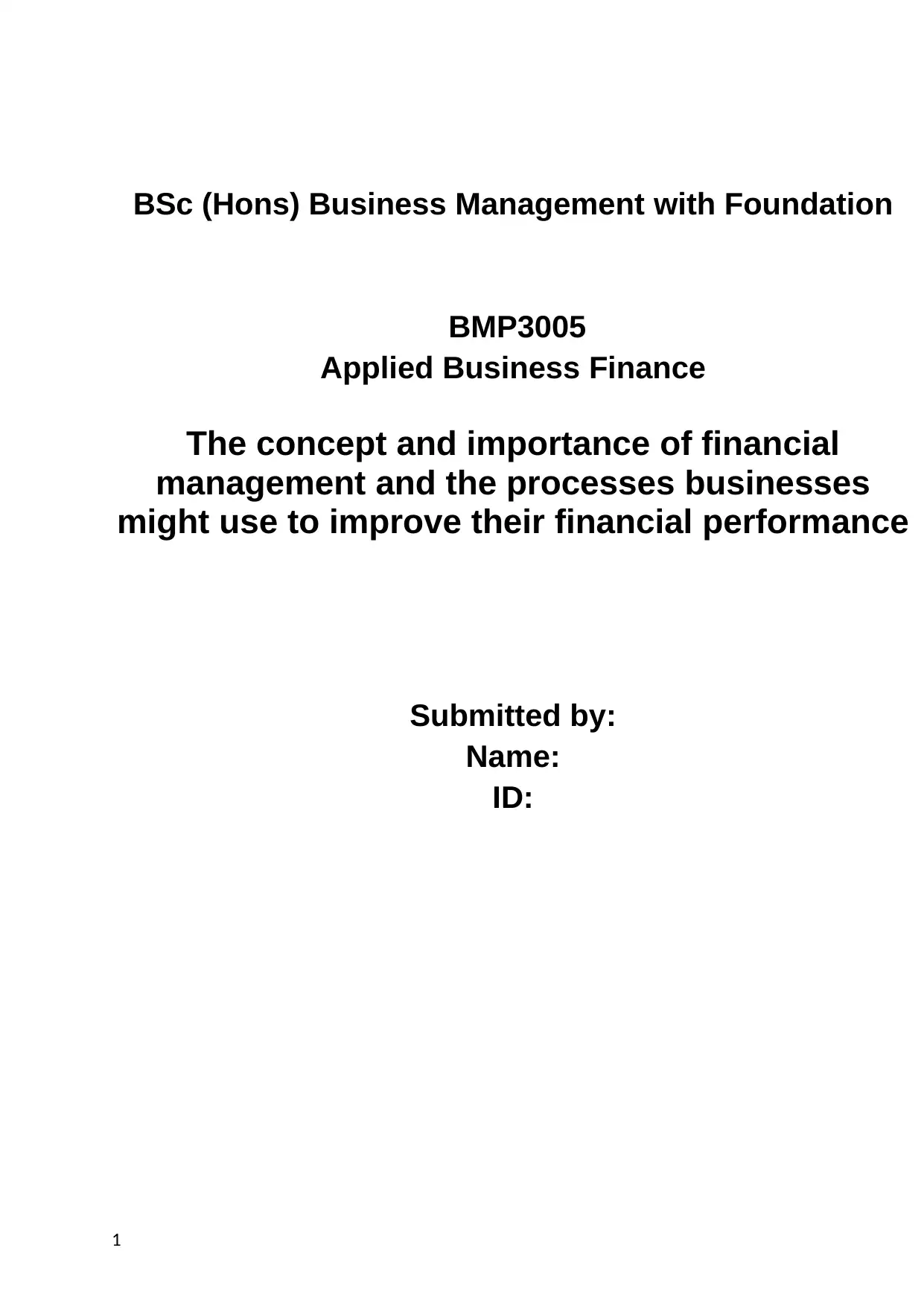
BSc (Hons) Business Management with Foundation
BMP3005
Applied Business Finance
The concept and importance of financial
management and the processes businesses
might use to improve their financial performance
Submitted by:
Name:
ID:
1
BMP3005
Applied Business Finance
The concept and importance of financial
management and the processes businesses
might use to improve their financial performance
Submitted by:
Name:
ID:
1
Paraphrase This Document
Need a fresh take? Get an instant paraphrase of this document with our AI Paraphraser
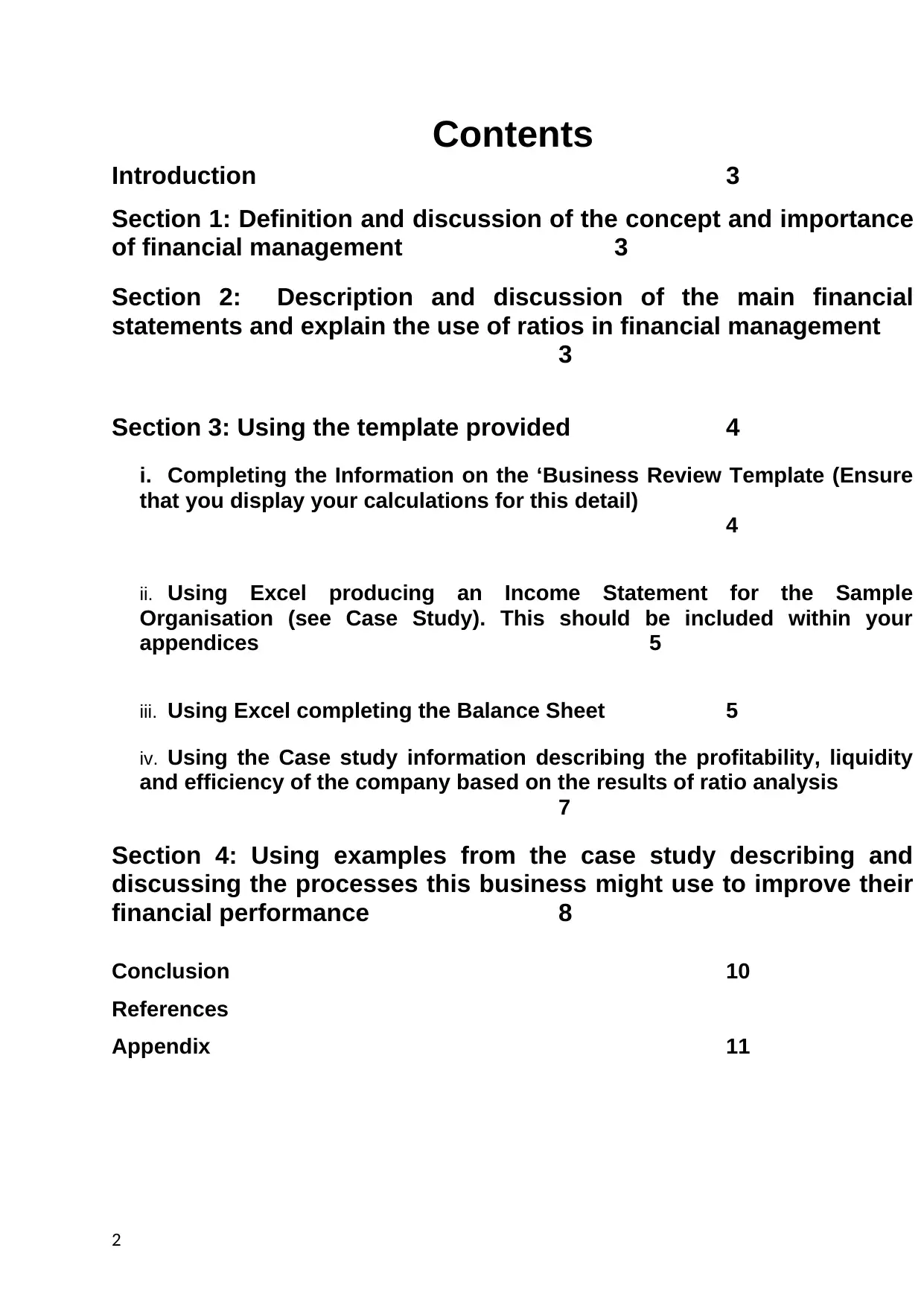
Contents
Introduction 3
Section 1: Definition and discussion of the concept and importance
of financial management 3
Section 2: Description and discussion of the main financial
statements and explain the use of ratios in financial management
3
Section 3: Using the template provided 4
i. Completing the Information on the ‘Business Review Template (Ensure
that you display your calculations for this detail)
4
ii. Using Excel producing an Income Statement for the Sample
Organisation (see Case Study). This should be included within your
appendices 5
iii. Using Excel completing the Balance Sheet 5
iv. Using the Case study information describing the profitability, liquidity
and efficiency of the company based on the results of ratio analysis
7
Section 4: Using examples from the case study describing and
discussing the processes this business might use to improve their
financial performance 8
Conclusion 10
References
Appendix 11
2
Introduction 3
Section 1: Definition and discussion of the concept and importance
of financial management 3
Section 2: Description and discussion of the main financial
statements and explain the use of ratios in financial management
3
Section 3: Using the template provided 4
i. Completing the Information on the ‘Business Review Template (Ensure
that you display your calculations for this detail)
4
ii. Using Excel producing an Income Statement for the Sample
Organisation (see Case Study). This should be included within your
appendices 5
iii. Using Excel completing the Balance Sheet 5
iv. Using the Case study information describing the profitability, liquidity
and efficiency of the company based on the results of ratio analysis
7
Section 4: Using examples from the case study describing and
discussing the processes this business might use to improve their
financial performance 8
Conclusion 10
References
Appendix 11
2
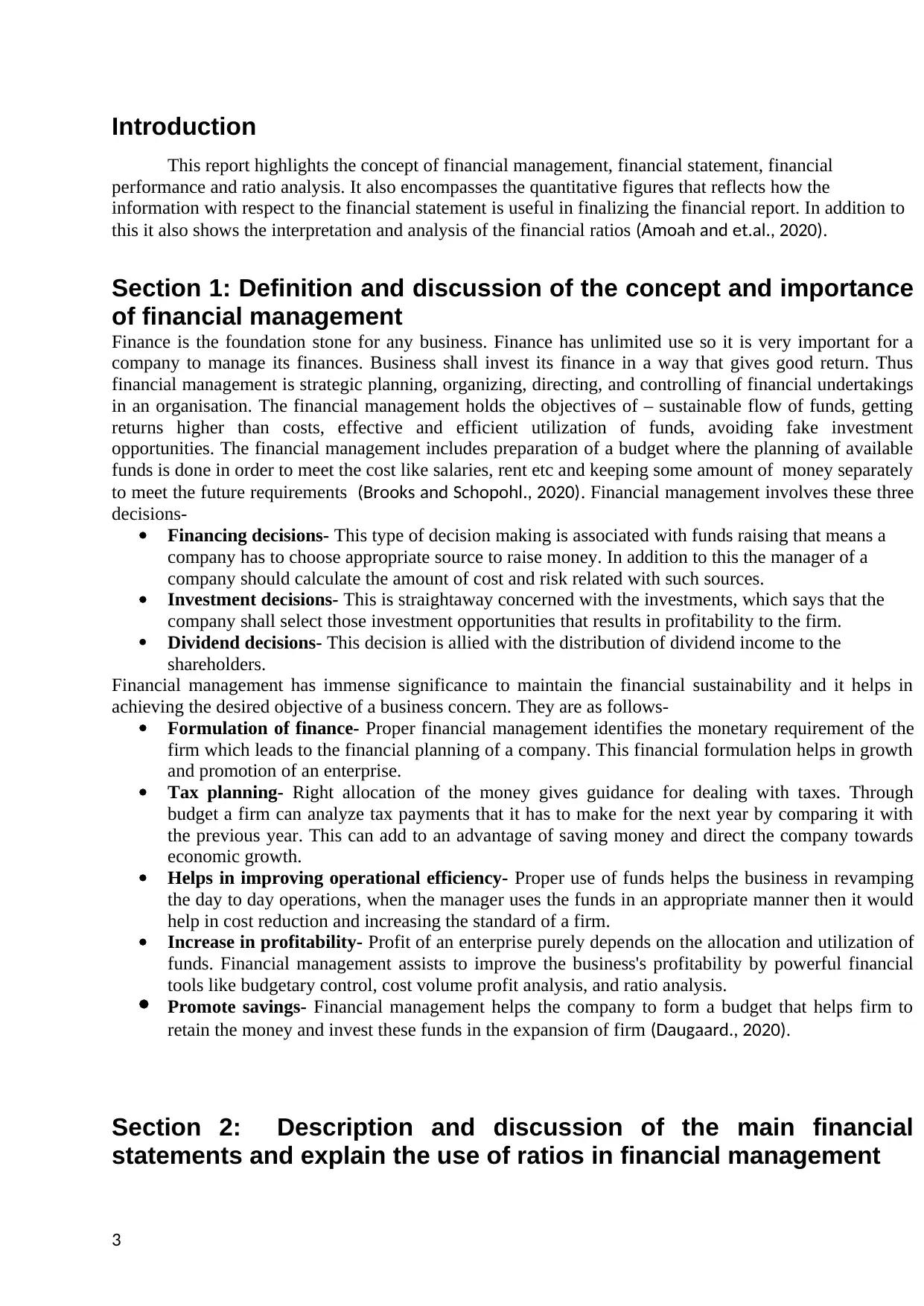
Introduction
This report highlights the concept of financial management, financial statement, financial
performance and ratio analysis. It also encompasses the quantitative figures that reflects how the
information with respect to the financial statement is useful in finalizing the financial report. In addition to
this it also shows the interpretation and analysis of the financial ratios (Amoah and et.al., 2020).
Section 1: Definition and discussion of the concept and importance
of financial management
Finance is the foundation stone for any business. Finance has unlimited use so it is very important for a
company to manage its finances. Business shall invest its finance in a way that gives good return. Thus
financial management is strategic planning, organizing, directing, and controlling of financial undertakings
in an organisation. The financial management holds the objectives of – sustainable flow of funds, getting
returns higher than costs, effective and efficient utilization of funds, avoiding fake investment
opportunities. The financial management includes preparation of a budget where the planning of available
funds is done in order to meet the cost like salaries, rent etc and keeping some amount of money separately
to meet the future requirements (Brooks and Schopohl., 2020). Financial management involves these three
decisions-
Financing decisions- This type of decision making is associated with funds raising that means a
company has to choose appropriate source to raise money. In addition to this the manager of a
company should calculate the amount of cost and risk related with such sources.
Investment decisions- This is straightaway concerned with the investments, which says that the
company shall select those investment opportunities that results in profitability to the firm.
Dividend decisions- This decision is allied with the distribution of dividend income to the
shareholders.
Financial management has immense significance to maintain the financial sustainability and it helps in
achieving the desired objective of a business concern. They are as follows-
Formulation of finance- Proper financial management identifies the monetary requirement of the
firm which leads to the financial planning of a company. This financial formulation helps in growth
and promotion of an enterprise.
Tax planning- Right allocation of the money gives guidance for dealing with taxes. Through
budget a firm can analyze tax payments that it has to make for the next year by comparing it with
the previous year. This can add to an advantage of saving money and direct the company towards
economic growth.
Helps in improving operational efficiency- Proper use of funds helps the business in revamping
the day to day operations, when the manager uses the funds in an appropriate manner then it would
help in cost reduction and increasing the standard of a firm.
Increase in profitability- Profit of an enterprise purely depends on the allocation and utilization of
funds. Financial management assists to improve the business's profitability by powerful financial
tools like budgetary control, cost volume profit analysis, and ratio analysis.
Promote savings- Financial management helps the company to form a budget that helps firm to
retain the money and invest these funds in the expansion of firm (Daugaard., 2020).
Section 2: Description and discussion of the main financial
statements and explain the use of ratios in financial management
3
This report highlights the concept of financial management, financial statement, financial
performance and ratio analysis. It also encompasses the quantitative figures that reflects how the
information with respect to the financial statement is useful in finalizing the financial report. In addition to
this it also shows the interpretation and analysis of the financial ratios (Amoah and et.al., 2020).
Section 1: Definition and discussion of the concept and importance
of financial management
Finance is the foundation stone for any business. Finance has unlimited use so it is very important for a
company to manage its finances. Business shall invest its finance in a way that gives good return. Thus
financial management is strategic planning, organizing, directing, and controlling of financial undertakings
in an organisation. The financial management holds the objectives of – sustainable flow of funds, getting
returns higher than costs, effective and efficient utilization of funds, avoiding fake investment
opportunities. The financial management includes preparation of a budget where the planning of available
funds is done in order to meet the cost like salaries, rent etc and keeping some amount of money separately
to meet the future requirements (Brooks and Schopohl., 2020). Financial management involves these three
decisions-
Financing decisions- This type of decision making is associated with funds raising that means a
company has to choose appropriate source to raise money. In addition to this the manager of a
company should calculate the amount of cost and risk related with such sources.
Investment decisions- This is straightaway concerned with the investments, which says that the
company shall select those investment opportunities that results in profitability to the firm.
Dividend decisions- This decision is allied with the distribution of dividend income to the
shareholders.
Financial management has immense significance to maintain the financial sustainability and it helps in
achieving the desired objective of a business concern. They are as follows-
Formulation of finance- Proper financial management identifies the monetary requirement of the
firm which leads to the financial planning of a company. This financial formulation helps in growth
and promotion of an enterprise.
Tax planning- Right allocation of the money gives guidance for dealing with taxes. Through
budget a firm can analyze tax payments that it has to make for the next year by comparing it with
the previous year. This can add to an advantage of saving money and direct the company towards
economic growth.
Helps in improving operational efficiency- Proper use of funds helps the business in revamping
the day to day operations, when the manager uses the funds in an appropriate manner then it would
help in cost reduction and increasing the standard of a firm.
Increase in profitability- Profit of an enterprise purely depends on the allocation and utilization of
funds. Financial management assists to improve the business's profitability by powerful financial
tools like budgetary control, cost volume profit analysis, and ratio analysis.
Promote savings- Financial management helps the company to form a budget that helps firm to
retain the money and invest these funds in the expansion of firm (Daugaard., 2020).
Section 2: Description and discussion of the main financial
statements and explain the use of ratios in financial management
3
⊘ This is a preview!⊘
Do you want full access?
Subscribe today to unlock all pages.

Trusted by 1+ million students worldwide
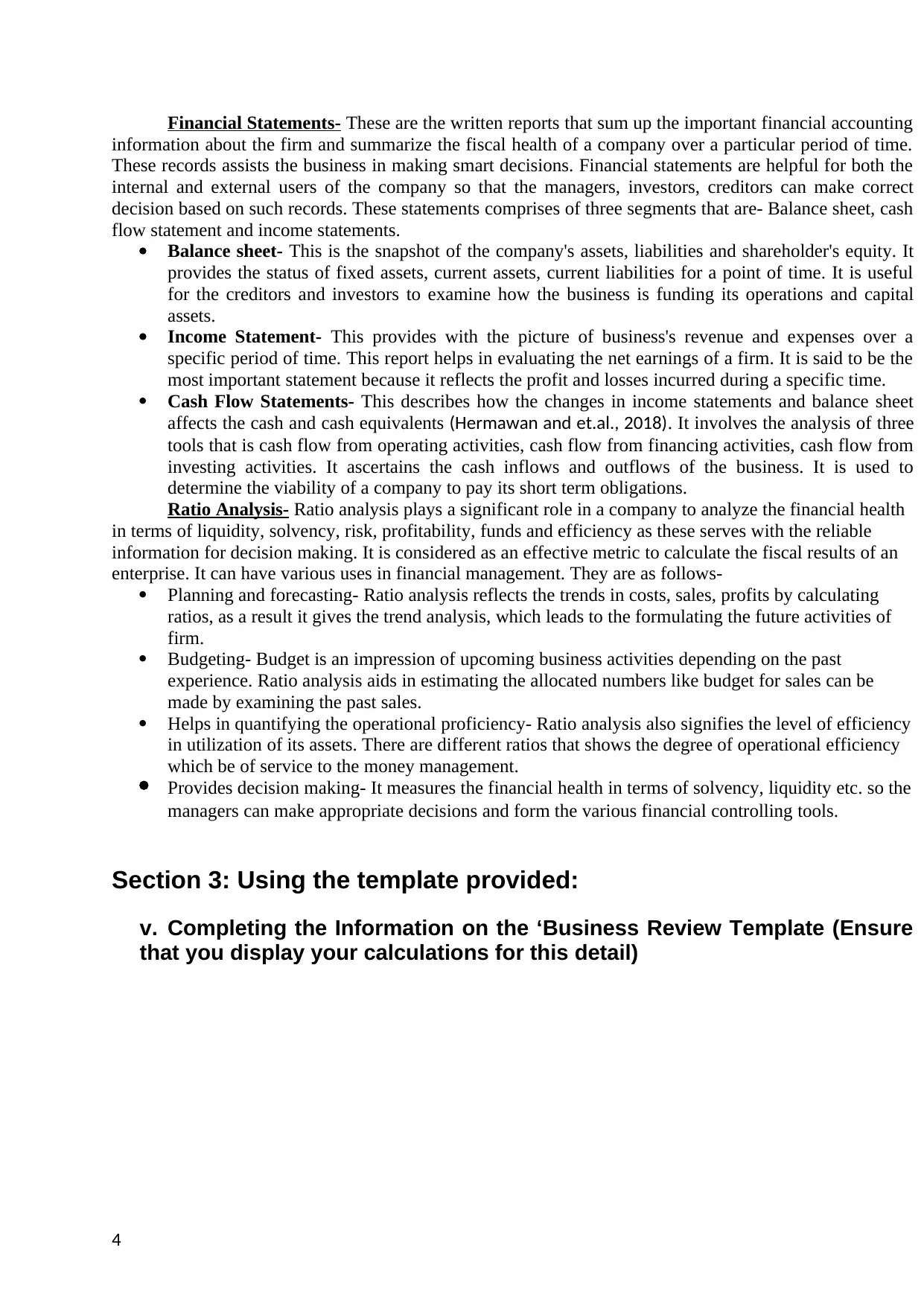
Financial Statements- These are the written reports that sum up the important financial accounting
information about the firm and summarize the fiscal health of a company over a particular period of time.
These records assists the business in making smart decisions. Financial statements are helpful for both the
internal and external users of the company so that the managers, investors, creditors can make correct
decision based on such records. These statements comprises of three segments that are- Balance sheet, cash
flow statement and income statements.
Balance sheet- This is the snapshot of the company's assets, liabilities and shareholder's equity. It
provides the status of fixed assets, current assets, current liabilities for a point of time. It is useful
for the creditors and investors to examine how the business is funding its operations and capital
assets.
Income Statement- This provides with the picture of business's revenue and expenses over a
specific period of time. This report helps in evaluating the net earnings of a firm. It is said to be the
most important statement because it reflects the profit and losses incurred during a specific time.
Cash Flow Statements- This describes how the changes in income statements and balance sheet
affects the cash and cash equivalents (Hermawan and et.al., 2018). It involves the analysis of three
tools that is cash flow from operating activities, cash flow from financing activities, cash flow from
investing activities. It ascertains the cash inflows and outflows of the business. It is used to
determine the viability of a company to pay its short term obligations.
Ratio Analysis- Ratio analysis plays a significant role in a company to analyze the financial health
in terms of liquidity, solvency, risk, profitability, funds and efficiency as these serves with the reliable
information for decision making. It is considered as an effective metric to calculate the fiscal results of an
enterprise. It can have various uses in financial management. They are as follows-
Planning and forecasting- Ratio analysis reflects the trends in costs, sales, profits by calculating
ratios, as a result it gives the trend analysis, which leads to the formulating the future activities of
firm.
Budgeting- Budget is an impression of upcoming business activities depending on the past
experience. Ratio analysis aids in estimating the allocated numbers like budget for sales can be
made by examining the past sales.
Helps in quantifying the operational proficiency- Ratio analysis also signifies the level of efficiency
in utilization of its assets. There are different ratios that shows the degree of operational efficiency
which be of service to the money management.
Provides decision making- It measures the financial health in terms of solvency, liquidity etc. so the
managers can make appropriate decisions and form the various financial controlling tools.
Section 3: Using the template provided:
v. Completing the Information on the ‘Business Review Template (Ensure
that you display your calculations for this detail)
4
information about the firm and summarize the fiscal health of a company over a particular period of time.
These records assists the business in making smart decisions. Financial statements are helpful for both the
internal and external users of the company so that the managers, investors, creditors can make correct
decision based on such records. These statements comprises of three segments that are- Balance sheet, cash
flow statement and income statements.
Balance sheet- This is the snapshot of the company's assets, liabilities and shareholder's equity. It
provides the status of fixed assets, current assets, current liabilities for a point of time. It is useful
for the creditors and investors to examine how the business is funding its operations and capital
assets.
Income Statement- This provides with the picture of business's revenue and expenses over a
specific period of time. This report helps in evaluating the net earnings of a firm. It is said to be the
most important statement because it reflects the profit and losses incurred during a specific time.
Cash Flow Statements- This describes how the changes in income statements and balance sheet
affects the cash and cash equivalents (Hermawan and et.al., 2018). It involves the analysis of three
tools that is cash flow from operating activities, cash flow from financing activities, cash flow from
investing activities. It ascertains the cash inflows and outflows of the business. It is used to
determine the viability of a company to pay its short term obligations.
Ratio Analysis- Ratio analysis plays a significant role in a company to analyze the financial health
in terms of liquidity, solvency, risk, profitability, funds and efficiency as these serves with the reliable
information for decision making. It is considered as an effective metric to calculate the fiscal results of an
enterprise. It can have various uses in financial management. They are as follows-
Planning and forecasting- Ratio analysis reflects the trends in costs, sales, profits by calculating
ratios, as a result it gives the trend analysis, which leads to the formulating the future activities of
firm.
Budgeting- Budget is an impression of upcoming business activities depending on the past
experience. Ratio analysis aids in estimating the allocated numbers like budget for sales can be
made by examining the past sales.
Helps in quantifying the operational proficiency- Ratio analysis also signifies the level of efficiency
in utilization of its assets. There are different ratios that shows the degree of operational efficiency
which be of service to the money management.
Provides decision making- It measures the financial health in terms of solvency, liquidity etc. so the
managers can make appropriate decisions and form the various financial controlling tools.
Section 3: Using the template provided:
v. Completing the Information on the ‘Business Review Template (Ensure
that you display your calculations for this detail)
4
Paraphrase This Document
Need a fresh take? Get an instant paraphrase of this document with our AI Paraphraser
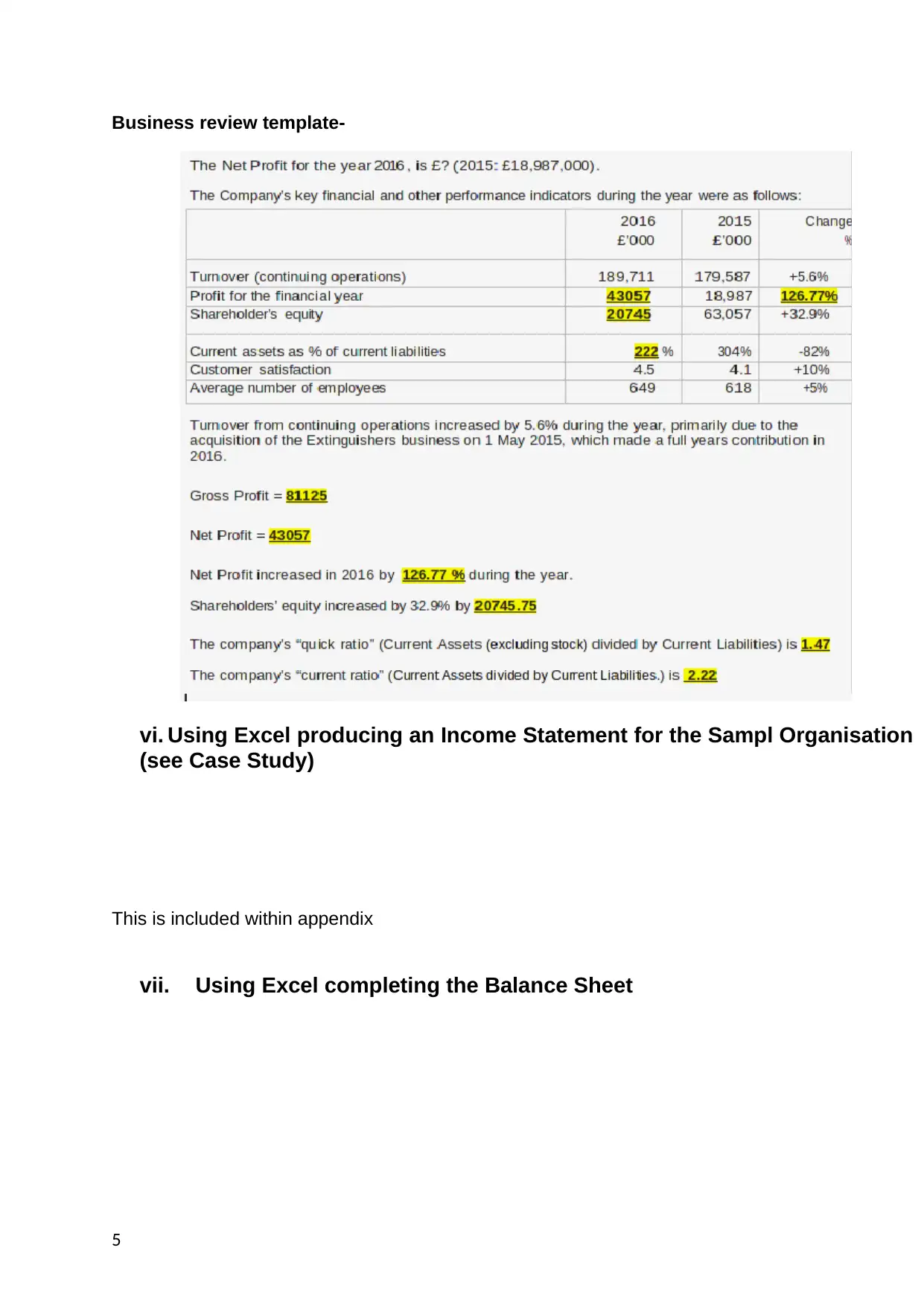
Business review template-
vi. Using Excel producing an Income Statement for the Sampl Organisation
(see Case Study)
This is included within appendix
vii. Using Excel completing the Balance Sheet
5
vi. Using Excel producing an Income Statement for the Sampl Organisation
(see Case Study)
This is included within appendix
vii. Using Excel completing the Balance Sheet
5
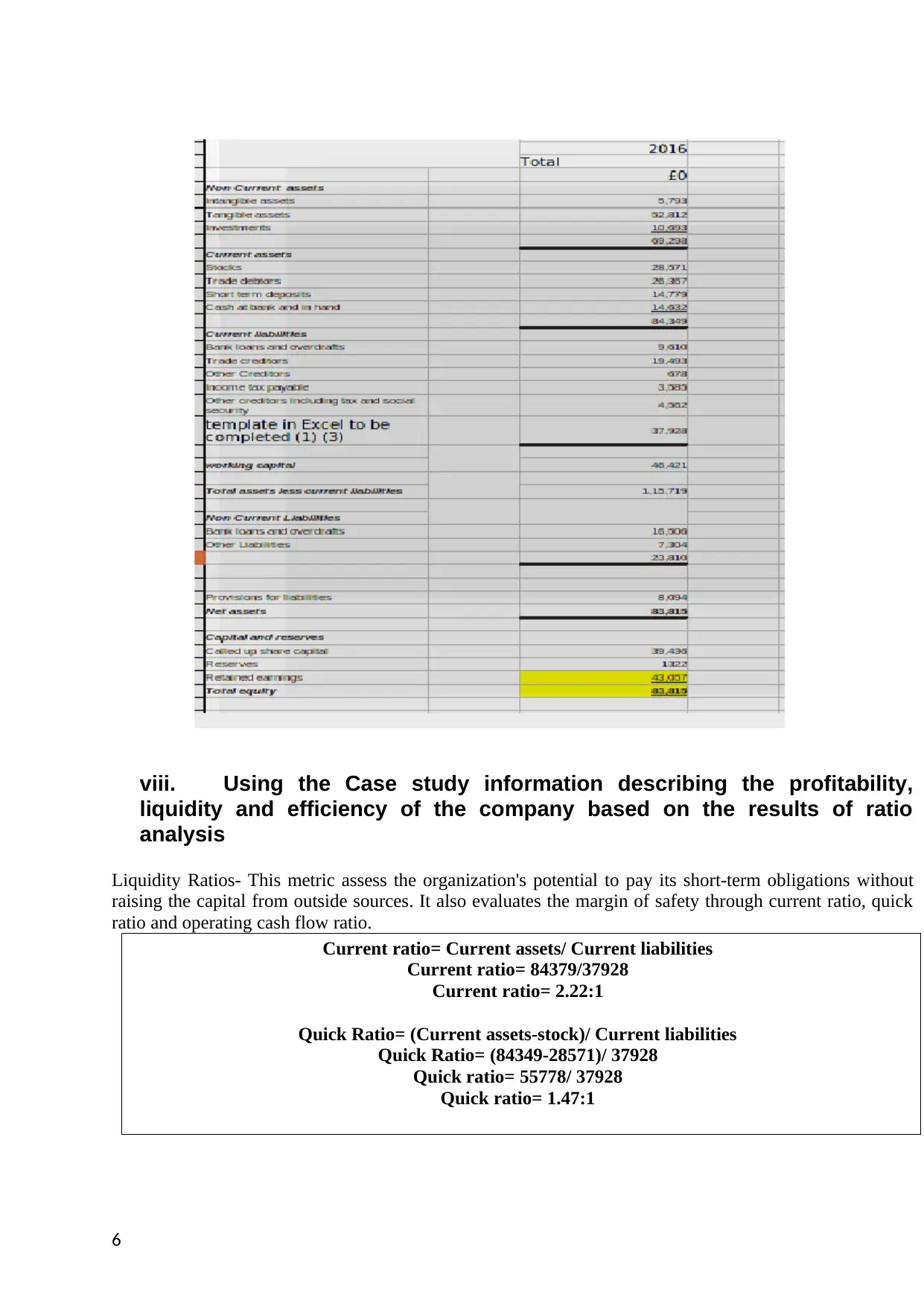
viii. Using the Case study information describing the profitability,
liquidity and efficiency of the company based on the results of ratio
analysis
Liquidity Ratios- This metric assess the organization's potential to pay its short-term obligations without
raising the capital from outside sources. It also evaluates the margin of safety through current ratio, quick
ratio and operating cash flow ratio.
Current ratio= Current assets/ Current liabilities
Current ratio= 84379/37928
Current ratio= 2.22:1
Quick Ratio= (Current assets-stock)/ Current liabilities
Quick Ratio= (84349-28571)/ 37928
Quick ratio= 55778/ 37928
Quick ratio= 1.47:1
6
liquidity and efficiency of the company based on the results of ratio
analysis
Liquidity Ratios- This metric assess the organization's potential to pay its short-term obligations without
raising the capital from outside sources. It also evaluates the margin of safety through current ratio, quick
ratio and operating cash flow ratio.
Current ratio= Current assets/ Current liabilities
Current ratio= 84379/37928
Current ratio= 2.22:1
Quick Ratio= (Current assets-stock)/ Current liabilities
Quick Ratio= (84349-28571)/ 37928
Quick ratio= 55778/ 37928
Quick ratio= 1.47:1
6
⊘ This is a preview!⊘
Do you want full access?
Subscribe today to unlock all pages.

Trusted by 1+ million students worldwide
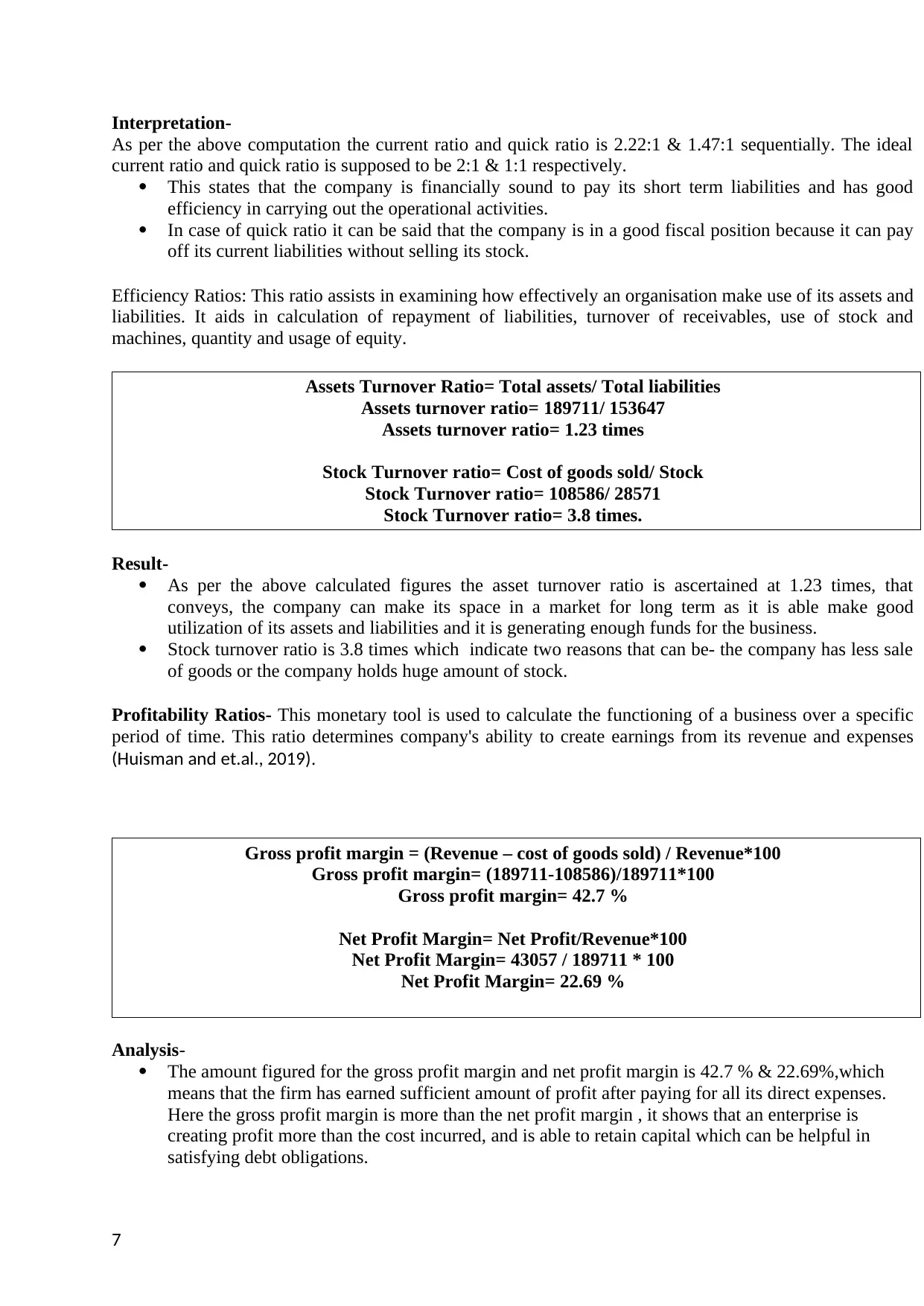
Interpretation-
As per the above computation the current ratio and quick ratio is 2.22:1 & 1.47:1 sequentially. The ideal
current ratio and quick ratio is supposed to be 2:1 & 1:1 respectively.
This states that the company is financially sound to pay its short term liabilities and has good
efficiency in carrying out the operational activities.
In case of quick ratio it can be said that the company is in a good fiscal position because it can pay
off its current liabilities without selling its stock.
Efficiency Ratios: This ratio assists in examining how effectively an organisation make use of its assets and
liabilities. It aids in calculation of repayment of liabilities, turnover of receivables, use of stock and
machines, quantity and usage of equity.
Assets Turnover Ratio= Total assets/ Total liabilities
Assets turnover ratio= 189711/ 153647
Assets turnover ratio= 1.23 times
Stock Turnover ratio= Cost of goods sold/ Stock
Stock Turnover ratio= 108586/ 28571
Stock Turnover ratio= 3.8 times.
Result-
As per the above calculated figures the asset turnover ratio is ascertained at 1.23 times, that
conveys, the company can make its space in a market for long term as it is able make good
utilization of its assets and liabilities and it is generating enough funds for the business.
Stock turnover ratio is 3.8 times which indicate two reasons that can be- the company has less sale
of goods or the company holds huge amount of stock.
Profitability Ratios- This monetary tool is used to calculate the functioning of a business over a specific
period of time. This ratio determines company's ability to create earnings from its revenue and expenses
(Huisman and et.al., 2019).
Gross profit margin = (Revenue – cost of goods sold) / Revenue*100
Gross profit margin= (189711-108586)/189711*100
Gross profit margin= 42.7 %
Net Profit Margin= Net Profit/Revenue*100
Net Profit Margin= 43057 / 189711 * 100
Net Profit Margin= 22.69 %
Analysis-
The amount figured for the gross profit margin and net profit margin is 42.7 % & 22.69%,which
means that the firm has earned sufficient amount of profit after paying for all its direct expenses.
Here the gross profit margin is more than the net profit margin , it shows that an enterprise is
creating profit more than the cost incurred, and is able to retain capital which can be helpful in
satisfying debt obligations.
7
As per the above computation the current ratio and quick ratio is 2.22:1 & 1.47:1 sequentially. The ideal
current ratio and quick ratio is supposed to be 2:1 & 1:1 respectively.
This states that the company is financially sound to pay its short term liabilities and has good
efficiency in carrying out the operational activities.
In case of quick ratio it can be said that the company is in a good fiscal position because it can pay
off its current liabilities without selling its stock.
Efficiency Ratios: This ratio assists in examining how effectively an organisation make use of its assets and
liabilities. It aids in calculation of repayment of liabilities, turnover of receivables, use of stock and
machines, quantity and usage of equity.
Assets Turnover Ratio= Total assets/ Total liabilities
Assets turnover ratio= 189711/ 153647
Assets turnover ratio= 1.23 times
Stock Turnover ratio= Cost of goods sold/ Stock
Stock Turnover ratio= 108586/ 28571
Stock Turnover ratio= 3.8 times.
Result-
As per the above calculated figures the asset turnover ratio is ascertained at 1.23 times, that
conveys, the company can make its space in a market for long term as it is able make good
utilization of its assets and liabilities and it is generating enough funds for the business.
Stock turnover ratio is 3.8 times which indicate two reasons that can be- the company has less sale
of goods or the company holds huge amount of stock.
Profitability Ratios- This monetary tool is used to calculate the functioning of a business over a specific
period of time. This ratio determines company's ability to create earnings from its revenue and expenses
(Huisman and et.al., 2019).
Gross profit margin = (Revenue – cost of goods sold) / Revenue*100
Gross profit margin= (189711-108586)/189711*100
Gross profit margin= 42.7 %
Net Profit Margin= Net Profit/Revenue*100
Net Profit Margin= 43057 / 189711 * 100
Net Profit Margin= 22.69 %
Analysis-
The amount figured for the gross profit margin and net profit margin is 42.7 % & 22.69%,which
means that the firm has earned sufficient amount of profit after paying for all its direct expenses.
Here the gross profit margin is more than the net profit margin , it shows that an enterprise is
creating profit more than the cost incurred, and is able to retain capital which can be helpful in
satisfying debt obligations.
7
Paraphrase This Document
Need a fresh take? Get an instant paraphrase of this document with our AI Paraphraser
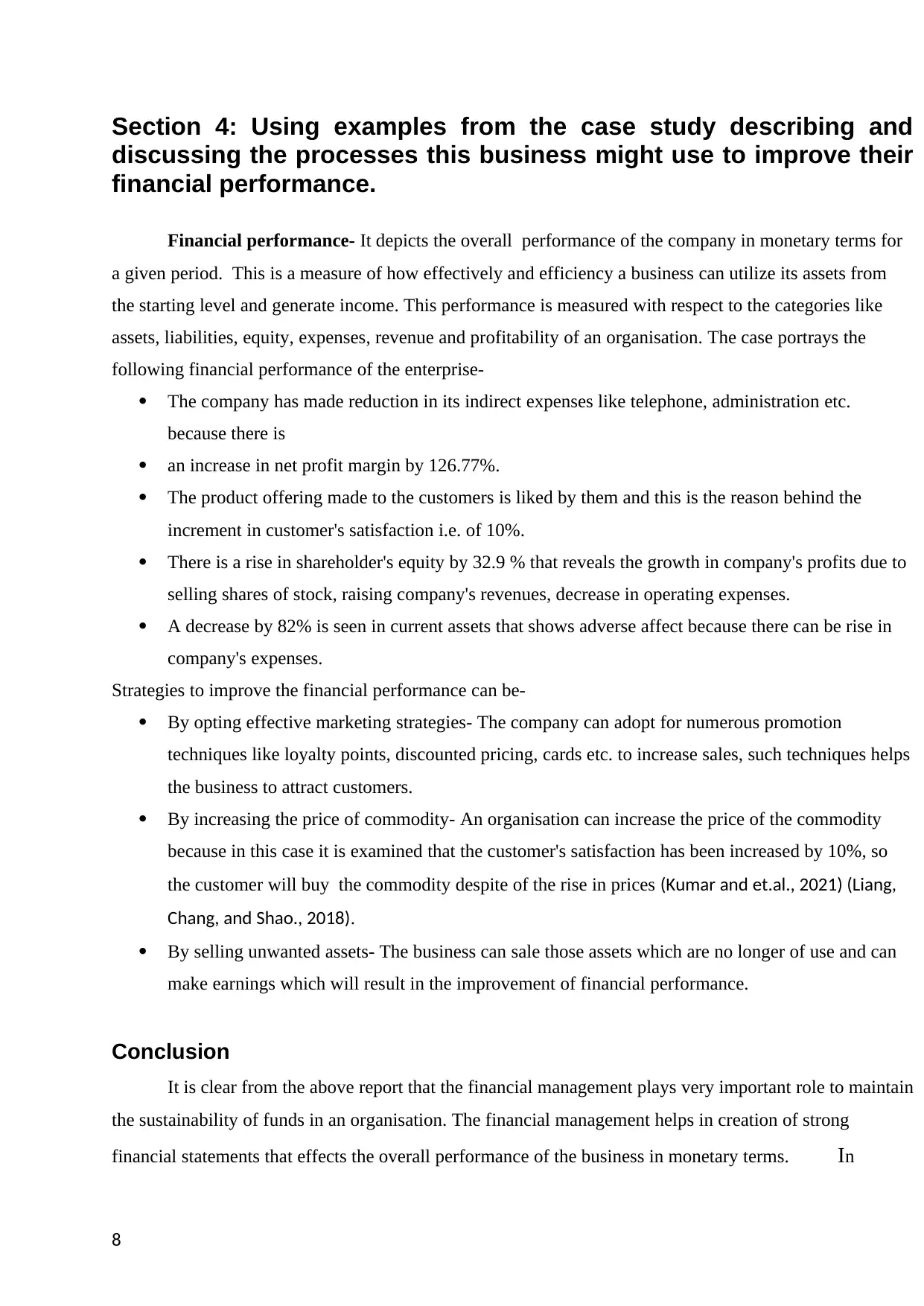
Section 4: Using examples from the case study describing and
discussing the processes this business might use to improve their
financial performance.
Financial performance- It depicts the overall performance of the company in monetary terms for
a given period. This is a measure of how effectively and efficiency a business can utilize its assets from
the starting level and generate income. This performance is measured with respect to the categories like
assets, liabilities, equity, expenses, revenue and profitability of an organisation. The case portrays the
following financial performance of the enterprise-
The company has made reduction in its indirect expenses like telephone, administration etc.
because there is
an increase in net profit margin by 126.77%.
The product offering made to the customers is liked by them and this is the reason behind the
increment in customer's satisfaction i.e. of 10%.
There is a rise in shareholder's equity by 32.9 % that reveals the growth in company's profits due to
selling shares of stock, raising company's revenues, decrease in operating expenses.
A decrease by 82% is seen in current assets that shows adverse affect because there can be rise in
company's expenses.
Strategies to improve the financial performance can be-
By opting effective marketing strategies- The company can adopt for numerous promotion
techniques like loyalty points, discounted pricing, cards etc. to increase sales, such techniques helps
the business to attract customers.
By increasing the price of commodity- An organisation can increase the price of the commodity
because in this case it is examined that the customer's satisfaction has been increased by 10%, so
the customer will buy the commodity despite of the rise in prices (Kumar and et.al., 2021) (Liang,
Chang, and Shao., 2018).
By selling unwanted assets- The business can sale those assets which are no longer of use and can
make earnings which will result in the improvement of financial performance.
Conclusion
It is clear from the above report that the financial management plays very important role to maintain
the sustainability of funds in an organisation. The financial management helps in creation of strong
financial statements that effects the overall performance of the business in monetary terms. In
8
discussing the processes this business might use to improve their
financial performance.
Financial performance- It depicts the overall performance of the company in monetary terms for
a given period. This is a measure of how effectively and efficiency a business can utilize its assets from
the starting level and generate income. This performance is measured with respect to the categories like
assets, liabilities, equity, expenses, revenue and profitability of an organisation. The case portrays the
following financial performance of the enterprise-
The company has made reduction in its indirect expenses like telephone, administration etc.
because there is
an increase in net profit margin by 126.77%.
The product offering made to the customers is liked by them and this is the reason behind the
increment in customer's satisfaction i.e. of 10%.
There is a rise in shareholder's equity by 32.9 % that reveals the growth in company's profits due to
selling shares of stock, raising company's revenues, decrease in operating expenses.
A decrease by 82% is seen in current assets that shows adverse affect because there can be rise in
company's expenses.
Strategies to improve the financial performance can be-
By opting effective marketing strategies- The company can adopt for numerous promotion
techniques like loyalty points, discounted pricing, cards etc. to increase sales, such techniques helps
the business to attract customers.
By increasing the price of commodity- An organisation can increase the price of the commodity
because in this case it is examined that the customer's satisfaction has been increased by 10%, so
the customer will buy the commodity despite of the rise in prices (Kumar and et.al., 2021) (Liang,
Chang, and Shao., 2018).
By selling unwanted assets- The business can sale those assets which are no longer of use and can
make earnings which will result in the improvement of financial performance.
Conclusion
It is clear from the above report that the financial management plays very important role to maintain
the sustainability of funds in an organisation. The financial management helps in creation of strong
financial statements that effects the overall performance of the business in monetary terms. In
8
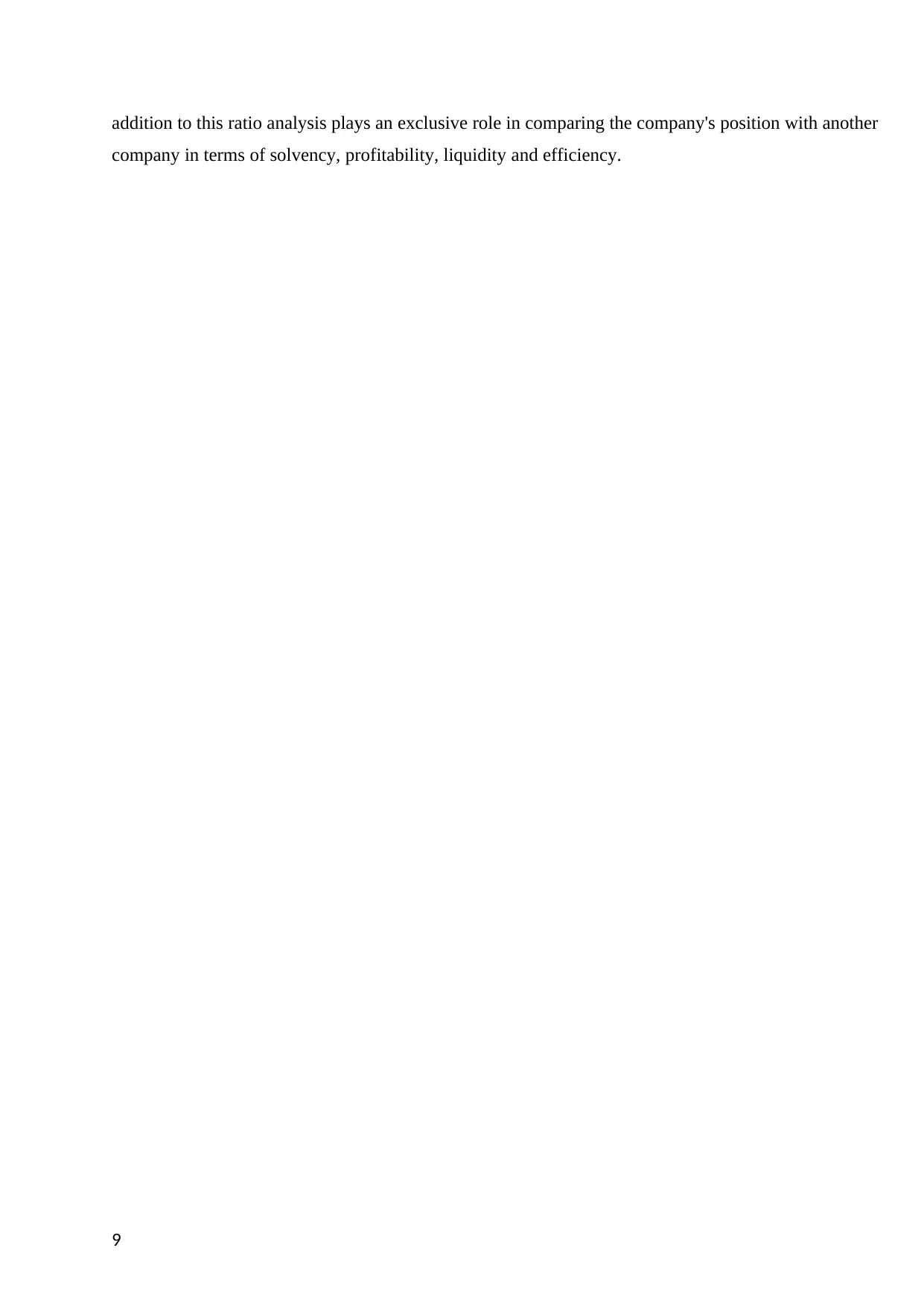
addition to this ratio analysis plays an exclusive role in comparing the company's position with another
company in terms of solvency, profitability, liquidity and efficiency.
9
company in terms of solvency, profitability, liquidity and efficiency.
9
⊘ This is a preview!⊘
Do you want full access?
Subscribe today to unlock all pages.

Trusted by 1+ million students worldwide
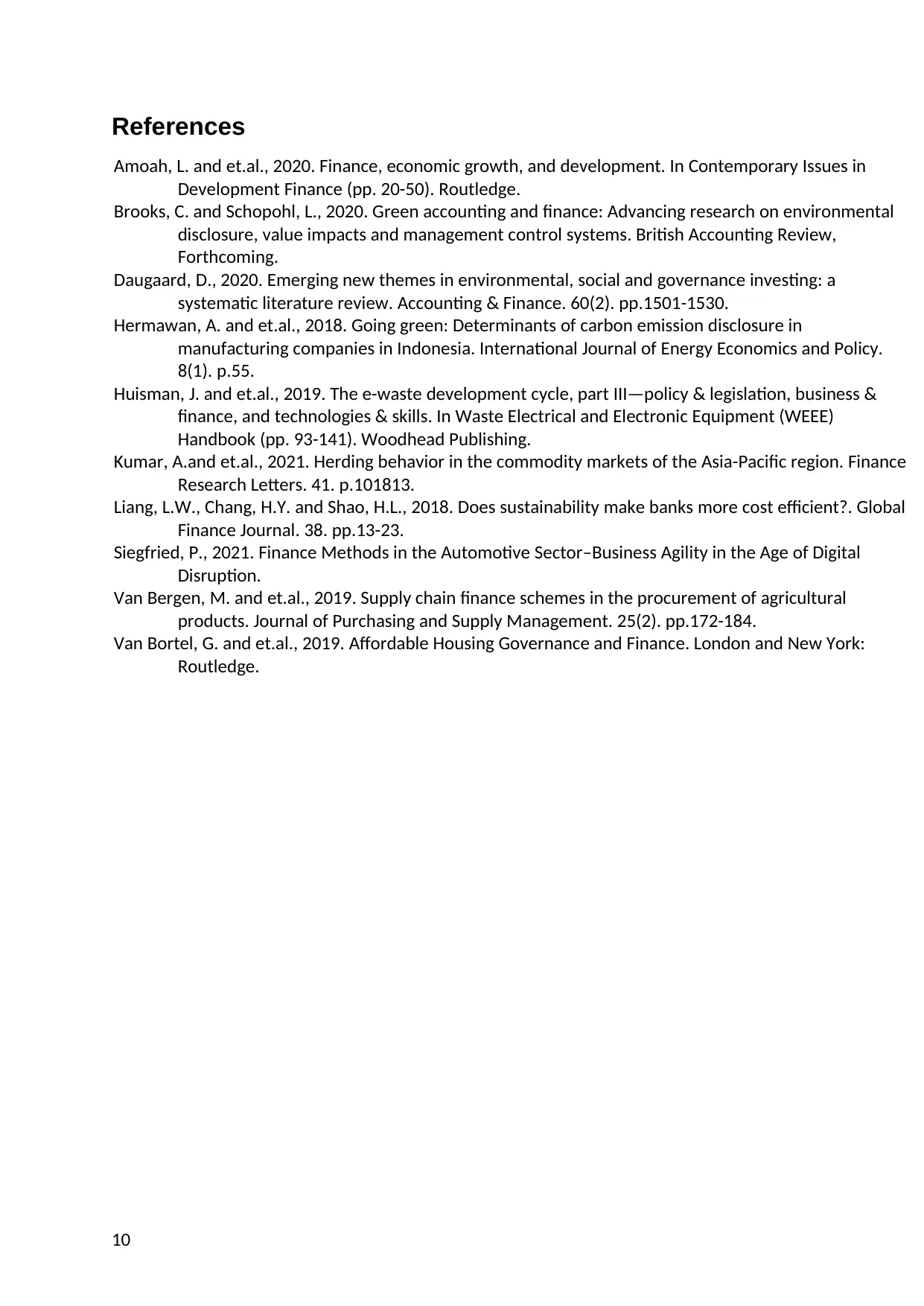
References
Amoah, L. and et.al., 2020. Finance, economic growth, and development. In Contemporary Issues in
Development Finance (pp. 20-50). Routledge.
Brooks, C. and Schopohl, L., 2020. Green accounting and finance: Advancing research on environmental
disclosure, value impacts and management control systems. British Accounting Review,
Forthcoming.
Daugaard, D., 2020. Emerging new themes in environmental, social and governance investing: a
systematic literature review. Accounting & Finance. 60(2). pp.1501-1530.
Hermawan, A. and et.al., 2018. Going green: Determinants of carbon emission disclosure in
manufacturing companies in Indonesia. International Journal of Energy Economics and Policy.
8(1). p.55.
Huisman, J. and et.al., 2019. The e-waste development cycle, part III—policy & legislation, business &
finance, and technologies & skills. In Waste Electrical and Electronic Equipment (WEEE)
Handbook (pp. 93-141). Woodhead Publishing.
Kumar, A.and et.al., 2021. Herding behavior in the commodity markets of the Asia-Pacific region. Finance
Research Letters. 41. p.101813.
Liang, L.W., Chang, H.Y. and Shao, H.L., 2018. Does sustainability make banks more cost efficient?. Global
Finance Journal. 38. pp.13-23.
Siegfried, P., 2021. Finance Methods in the Automotive Sector–Business Agility in the Age of Digital
Disruption.
Van Bergen, M. and et.al., 2019. Supply chain finance schemes in the procurement of agricultural
products. Journal of Purchasing and Supply Management. 25(2). pp.172-184.
Van Bortel, G. and et.al., 2019. Affordable Housing Governance and Finance. London and New York:
Routledge.
10
Amoah, L. and et.al., 2020. Finance, economic growth, and development. In Contemporary Issues in
Development Finance (pp. 20-50). Routledge.
Brooks, C. and Schopohl, L., 2020. Green accounting and finance: Advancing research on environmental
disclosure, value impacts and management control systems. British Accounting Review,
Forthcoming.
Daugaard, D., 2020. Emerging new themes in environmental, social and governance investing: a
systematic literature review. Accounting & Finance. 60(2). pp.1501-1530.
Hermawan, A. and et.al., 2018. Going green: Determinants of carbon emission disclosure in
manufacturing companies in Indonesia. International Journal of Energy Economics and Policy.
8(1). p.55.
Huisman, J. and et.al., 2019. The e-waste development cycle, part III—policy & legislation, business &
finance, and technologies & skills. In Waste Electrical and Electronic Equipment (WEEE)
Handbook (pp. 93-141). Woodhead Publishing.
Kumar, A.and et.al., 2021. Herding behavior in the commodity markets of the Asia-Pacific region. Finance
Research Letters. 41. p.101813.
Liang, L.W., Chang, H.Y. and Shao, H.L., 2018. Does sustainability make banks more cost efficient?. Global
Finance Journal. 38. pp.13-23.
Siegfried, P., 2021. Finance Methods in the Automotive Sector–Business Agility in the Age of Digital
Disruption.
Van Bergen, M. and et.al., 2019. Supply chain finance schemes in the procurement of agricultural
products. Journal of Purchasing and Supply Management. 25(2). pp.172-184.
Van Bortel, G. and et.al., 2019. Affordable Housing Governance and Finance. London and New York:
Routledge.
10
Paraphrase This Document
Need a fresh take? Get an instant paraphrase of this document with our AI Paraphraser

Appendix:
Income Statement
11
Income Statement
11
1 out of 11
Related Documents
Your All-in-One AI-Powered Toolkit for Academic Success.
+13062052269
info@desklib.com
Available 24*7 on WhatsApp / Email
![[object Object]](/_next/static/media/star-bottom.7253800d.svg)
Unlock your academic potential
Copyright © 2020–2025 A2Z Services. All Rights Reserved. Developed and managed by ZUCOL.

